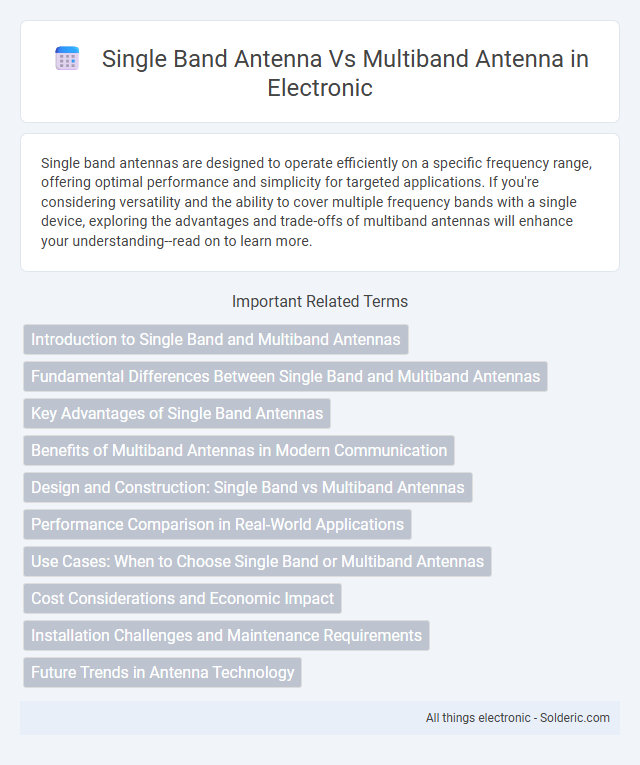Single band antennas are designed to operate efficiently on a specific frequency range, offering optimal performance and simplicity for targeted applications. If you're considering versatility and the ability to cover multiple frequency bands with a single device, exploring the advantages and trade-offs of multiband antennas will enhance your understanding--read on to learn more.
Comparison Table
| Feature | Single Band Antenna | Multiband Antenna |
|---|---|---|
| Frequency Range | Narrow, designed for one specific frequency | Broad, covers multiple frequency bands |
| Performance | Optimized for maximum efficiency on one band | Moderate efficiency across all supported bands |
| Applications | Specialized uses requiring high gain on a single frequency | Flexible usage across different communication systems |
| Design Complexity | Simple and cost-effective | Complex, often larger and more expensive |
| Size | Generally smaller and lightweight | Typically larger due to multi-resonant structures |
| Installation | Easy due to simpler structure | Requires careful tuning and placement |
| Cost | Lower initial cost | Higher initial and maintenance cost |
Introduction to Single Band and Multiband Antennas
Single band antennas are designed to operate efficiently at a specific frequency or narrow frequency range, providing optimal performance and signal clarity for that targeted band. Multiband antennas support multiple frequency bands within a single antenna structure, allowing versatile use across different communication systems without the need for multiple antennas. Your choice between single band and multiband antennas impacts signal quality, installation complexity, and overall system flexibility.
Fundamental Differences Between Single Band and Multiband Antennas
Single band antennas are designed to operate efficiently within a specific frequency range, providing optimal performance for targeted applications like FM radio or Wi-Fi at 2.4 GHz. Multiband antennas support multiple frequency bands through engineered elements or tuning, enabling seamless use across diverse communication standards such as GSM, LTE, and GPS. The fundamental difference lies in the antenna's structural complexity and frequency adaptability, where single band antennas offer simplicity and enhanced gain, while multiband antennas prioritize versatility and broader spectrum coverage.
Key Advantages of Single Band Antennas
Single band antennas offer superior performance by providing optimized gain and radiation patterns tailored for a specific frequency, ensuring minimal signal loss and maximum efficiency. Their simple design leads to easier installation, lower cost, and reduced interference compared to multiband antennas. If your communication needs target a specific frequency range, choosing a single band antenna can enhance signal clarity and reliability.
Benefits of Multiband Antennas in Modern Communication
Multiband antennas support multiple frequency bands, enhancing versatility and reducing the need for multiple antennas in modern communication systems. Their ability to operate efficiently across diverse frequencies ensures better signal quality and compatibility with various wireless standards such as LTE, 5G, and Wi-Fi. Choosing a multiband antenna optimizes your communication setup by providing seamless connectivity and minimizing hardware complexity.
Design and Construction: Single Band vs Multiband Antennas
Single band antennas feature a simpler design optimized for a specific frequency range, resulting in straightforward construction with fewer components and precise tuning for maximum efficiency. Multiband antennas incorporate complex structures such as traps, coils, or multiple elements to operate effectively across various frequency bands, which may increase size and construction complexity. Your choice depends on the balance between the ease of design in single band antennas and the versatile coverage offered by multiband alternatives.
Performance Comparison in Real-World Applications
Single band antennas deliver superior performance with higher gain and better signal clarity within their designated frequency range, making them ideal for specialized applications like FM radio or specific cellular bands. Multiband antennas offer the convenience of supporting multiple frequencies, but often experience trade-offs in efficiency and gain due to complex design compromises, resulting in slightly reduced signal strength and increased noise in real-world scenarios. In environments with diverse frequency requirements, multiband antennas provide flexibility, yet single band antennas consistently outperform in signal stability and interference resistance for targeted frequency use.
Use Cases: When to Choose Single Band or Multiband Antennas
Single band antennas are ideal for specialized applications requiring enhanced performance on a specific frequency, such as dedicated amateur radio bands or fixed wireless systems. Multiband antennas provide flexibility and convenience for operators needing to access multiple frequency ranges without changing equipment, making them suitable for emergency communications, field operations, and hobbyists engaging across various bands. Choosing between single and multiband antennas depends on the priority of tuning precision versus frequency versatility in the intended use case.
Cost Considerations and Economic Impact
Single band antennas typically incur lower initial costs due to simpler design and fewer components, making them more budget-friendly for specific frequency applications. Multiband antennas involve higher manufacturing and installation expenses because of complex architecture optimized for multiple frequency ranges, increasing upfront investment. Long-term economic impact favors multiband antennas in scenarios requiring versatile frequency coverage, reducing the need for multiple single band units and associated maintenance costs.
Installation Challenges and Maintenance Requirements
Single band antennas feature simpler installation processes due to their straightforward design and specific frequency focus, reducing complex tuning and alignment issues. Multiband antennas demand careful calibration and precise positioning to optimize performance across varying frequencies, often requiring expert setup to avoid interference and signal loss. Maintenance for single band antennas typically involves routine checks for physical damage, while multiband antennas require more frequent inspections and adjustments to ensure all bands function efficiently and reliably.
Future Trends in Antenna Technology
Single band antennas offer optimized performance and lower complexity for specific frequency ranges, but multiband antennas provide versatile connectivity across various bands, meeting the growing demand for compact, integrated devices. Future trends in antenna technology emphasize advanced materials like metamaterials and reconfigurable antennas that dynamically switch frequencies to enhance multiband capability, improving network efficiency and spectral utilization. Integration of AI-driven tuning and miniaturization techniques will further propel multiband antennas as the preferred choice for next-gen wireless communication systems.
single band antenna vs multiband antenna Infographic

 solderic.com
solderic.com